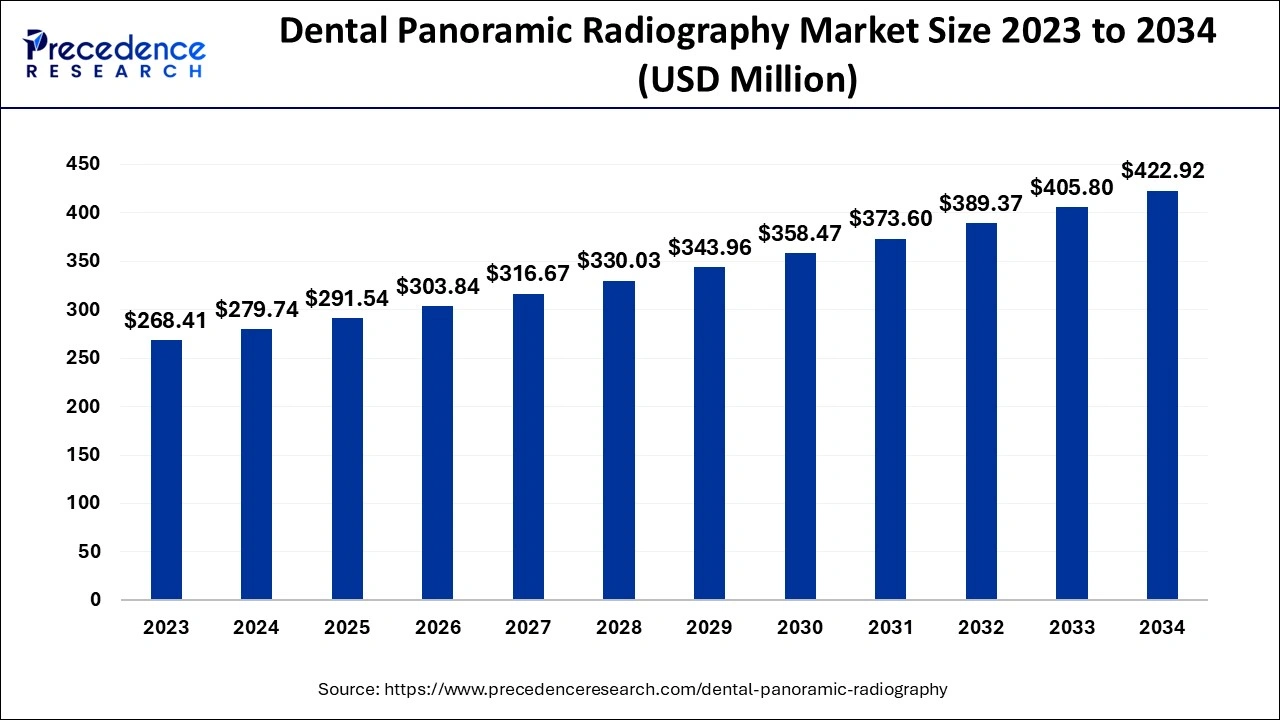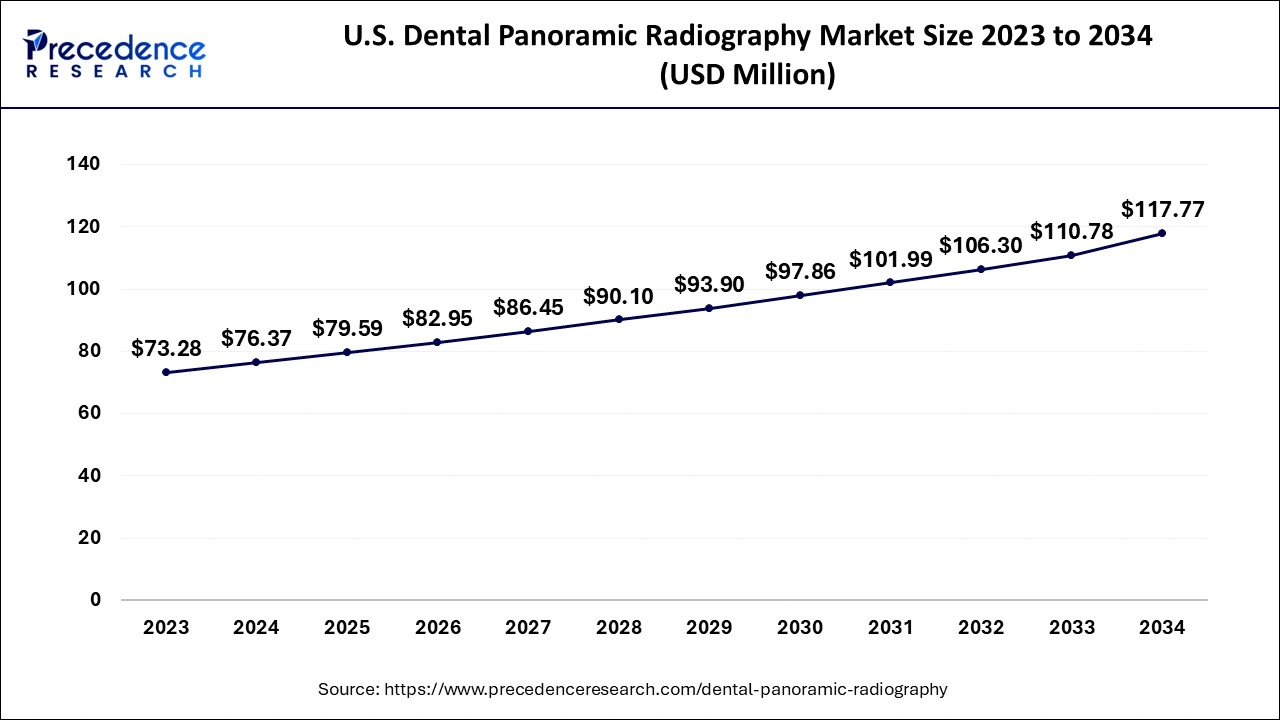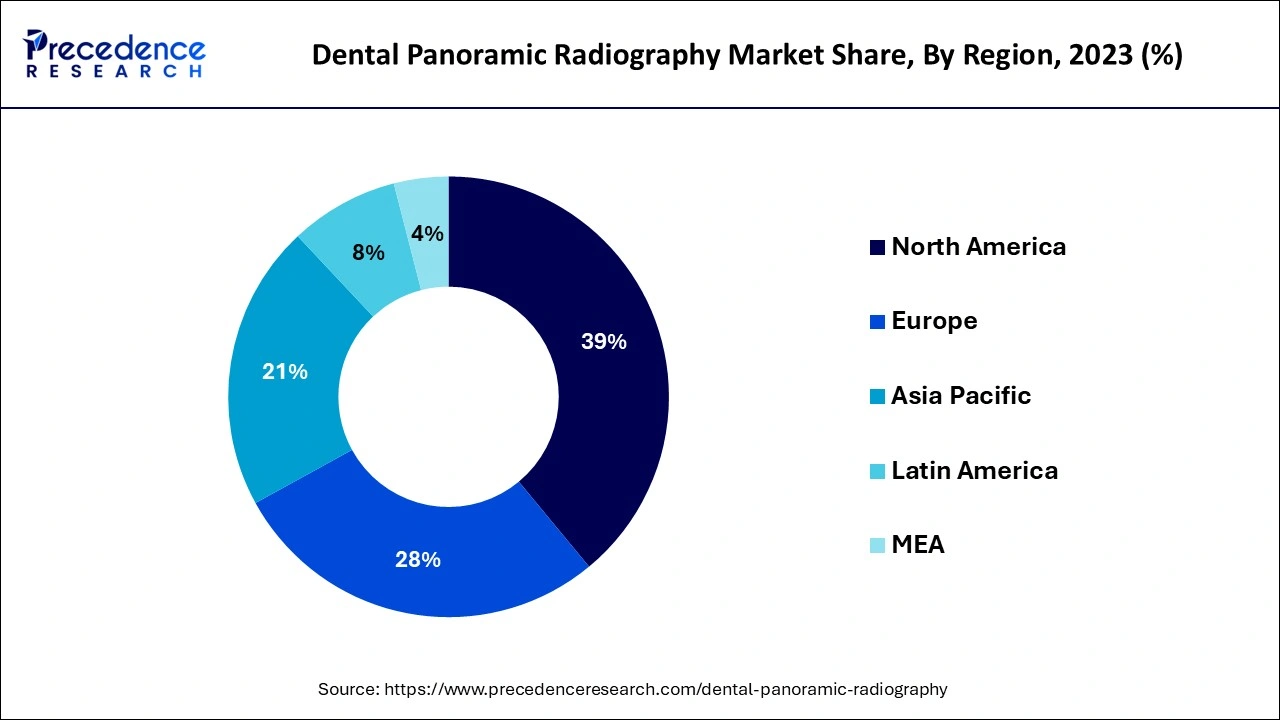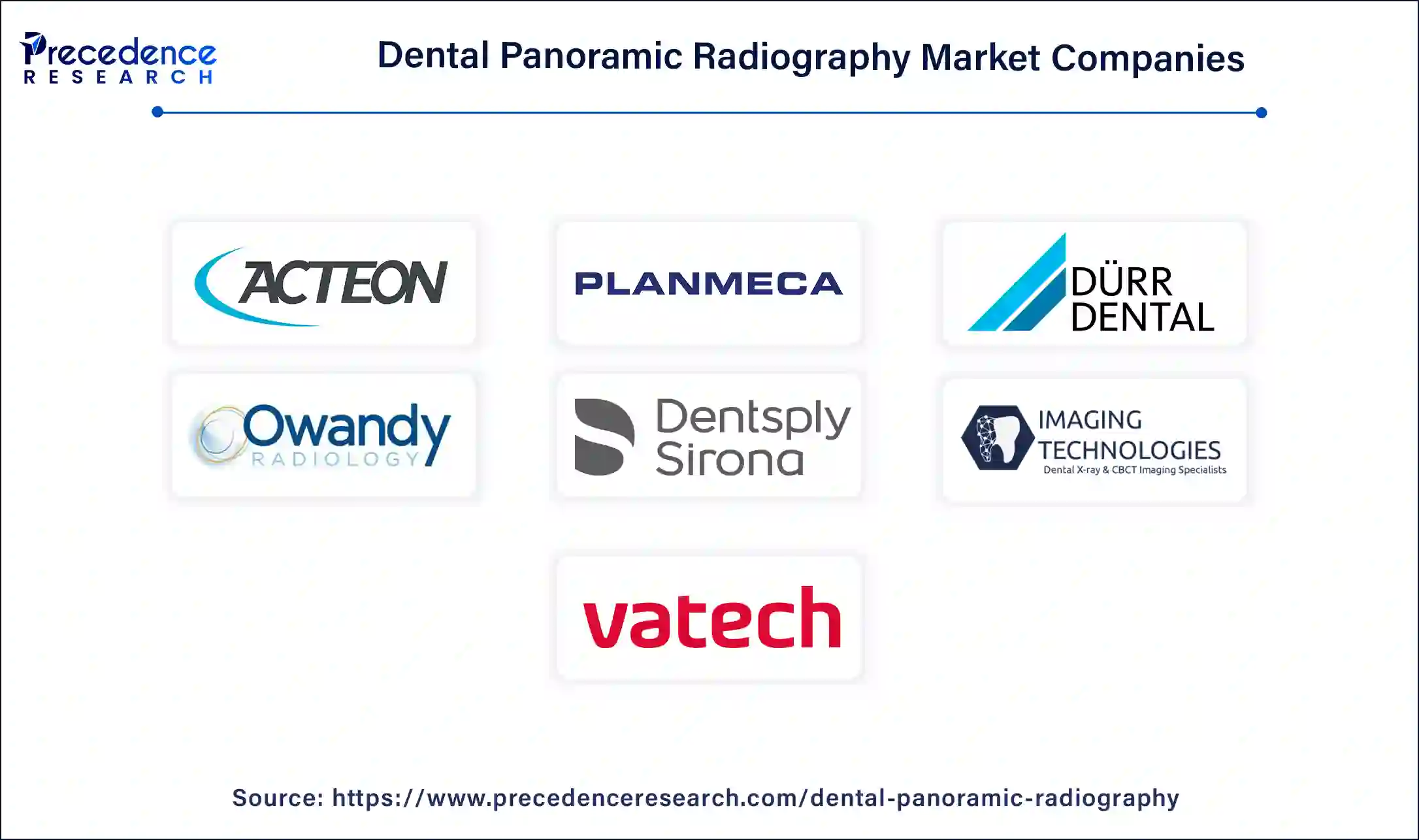January 2025
The global dental panoramic radiography market size accounted for USD 279.74 million in 2024, grew to USD 291.54 million in 2025 and is expected to be worth around USD 422.92 million by 2034, representing a CAGR of 4.22% between 2024 and 2034. The North America dental panoramic radiography market size is calculated at USD 109.10 million in 2024 and is estimated to grow at a CAGR of 4.34% during the forecast period.
The global dental panoramic radiography market size is calculated at USD 279.74 million in 2024 and is projected to surpass around USD 422.92 million by 2034, expanding at a CAGR of 4.22% from 2024 to 2034. The dental panoramic radiography market is driven by the rising incidence of periodontitis and implant dentistry.

The U.S. dental panoramic radiography market size is evaluated at USD 76.37 million in 2024 and is predicted to reach around USD 117.77 million by 2034, growing at a CAGR of 4.40% from 2024 to 2034.

North America dominated the dental panoramic radiography market in 2023, capturing the major market share. This is primarily due to its well-established healthcare system and easy accessibility to cutting-edge diagnosis solutions. Hospitals, ambulatory surgical centers, and dental clinics in the region are all well-equipped to install and run advanced panoramic radiography equipment. The U.S. is home to a large number of dentists and dental care facilities that are funded by both commercial insurance and government programs like Medicare and Medicaid. The availability of infrastructure has made the adoption of state-of-the-art dental imaging technologies easier.

Asia Pacific is projected to witness the fastest growth in the market during the forecast period. Due to increasing disposable income in several countries in the Asia Pacific, more people can now afford modern dental procedures. People in a better financial position are more likely to spend money on restorative and aesthetic dentistry, which sometimes requires panoramic radiographs to ensure proper treatment planning.
Dental panoramic radiography (DPR) refers to a 2-D dental X-ray of both the upper and lower jaw. It is a unique imaging method that captures the entire mouth in a single image. This method uses rotating X-ray equipment to continuously take several pictures, which are subsequently combined into a single panoramic image. Advancements in dental technologies have led to an advanced and efficient DPR. Because of DPR's thorough understanding of dental anatomy, better treatment planning is feasible for a variety of dental treatments, such as dental implants, orthodontics, and extractions.
According to a report published by the National Library of Medicine, a study examined the performance of a deep learning model in detecting Idiopathic osteosclerosis (IO) using a small dataset of dental panoramic radiographs with different contrasts and characteristics.
How is AI helping the Dental Panoramic Radiography Market Grow?
Artificial Intelligence (AI) systems can decrease human mistakes in image interpretation by emphasizing areas that should be taken seriously, like malignancies, periodontal disorders, or cavities. Better patient outcomes and early detection may result from this. It can predict results and suggest preventive actions by analyzing past patient data. AI can assist in identifying people who are more likely to experience certain dental problems, enabling the provision of preventative therapy. It makes dental treatment more accessible by allowing dentists to evaluate panoramic radiographs and use tele-dentistry platforms to conduct remote consultations with patients or other specialists based on the results.
| Report Coverage | Details |
| Market Size by 2034 | USD 422.92 Million |
| Market Size in 2024 | USD 279.74 Million |
| Market Growth Rate from 2024 to 2034 | CAGR of 4.22% |
| Largest Market | North America |
| Base Year | 2023 |
| Forecast Period | 2024 to 2034 |
| Segments Covered | Type, End-user, and Regions |
| Regions Covered | North America, Europe, Asia-Pacific, Latin America and Middle East & Africa |
Rising prevalence of dental disorders
Dentists increasingly use panoramic radiography to understand patients' oral health issues. This imaging technique provides important data on tooth alignment, jaw connections, and the existence of cysts or tumors to help with efficient treatment planning. The dental panoramic radiography market is growing as a result of higher investments made by commercial and public entities to improve access to advanced healthcare technologies and enhance the quality of care.
Growing awareness about the importance of oral health
Due to the growing awareness about the importance of oral care and preventative dental treatment, there has been more focus on the early detection of dental conditions such as gum disease, cavities, and oral malignancies. Comprehensive imaging, made possible by dental panoramic radiography, helps dentists spot possible issues at an early stage. Several public health campaigns and government initiatives have further raised awareness of oral health and educated the public, increasing dental visits and the need for panoramic radiography.
Lack of awareness about the benefits of panoramic radiography
Lack of awareness among the general population about the effectiveness, advantages, and safety of panoramic imaging over regular X-rays in disease diagnosis can reduce its need. This directly affects the market growth. In addition to this, concerns about radiation exposure can also deter patients from undergoing panoramic radiography, thus limiting its use to a certain extent and hampering the growth of the dental panoramic radiography market.
Increasing demand for cone-beam computed tomography (CBCT) and 3D imaging
Patients are increasingly looking for advanced imaging techniques as they become more aware of the importance of oral health. However, CBCT and 3D imaging are a perfect fit in this scenario. CBCT and 3D imaging provide high-resolution images, which improve anatomical structure visualization. As a result, dental conditions such as lesions, loss of bone, and other pathologies that may not appear early with conventional 2D panoramic radiography can be better detected.
The digital segment dominated the dental panoramic radiography market in 2023. This is mainly due to digital panoramic radiography systems outperform older film-based systems in terms of image quality and resolution. This makes it easier for dentists to identify dental diseases, especially complicated ones like impacted teeth, fractured jawbones, and temporomandibular joint (TMJ) abnormalities. Digital solutions further improve the workflow efficiency of dental clinics by accelerating image capture and processing time.
The analog segment is expected to grow rapidly during the forecast period. Healthcare professionals in underdeveloped nations of Africa, Asia, and Latin America often face financial constraints and restricted access to cutting-edge technologies. Therefore, there is a high demand for analog dental panoramic radiography in these nations, as analog systems are easily accessible, affordable, and user-friendly. Due to increased knowledge of oral health and a growth in the prevalence of dental problems, including cavities and periodontal disorders, there is also a steady increase in demand for dental treatment in these areas.
The solo practices segment dominated the dental panoramic radiography market with the largest share in 2023. When providing preventative and cosmetic dental services, solo practices are frequently at the forefront and greatly benefit from panoramic imaging. Panoramic photographs provide a thorough overview during routine dental check-ups to spot early signs of decay or other disorders. Panoramic radiography is required for dental implants, veneers, and orthodontic procedures to assess bone structure, tooth alignment, and other important variables. To meet patient expectations, solo practitioners are investing more in cutting-edge imaging equipment as the need for these services increases.
The DSO/group practices segment is anticipated to register the highest CAGR in the coming years. Diagnostic protocols are among the standardized processes that DSOs frequently use across their clinics. As a result, decisions about equipment purchases, such as panoramic radiography systems, are made at the organizational level, which speeds up adoption among various practices. Panoramic imaging is helpful for orthodontic treatment, implantology, and oral surgery, among other procedures that many DSOs and group offices offer under one roof. This increases the need for sophisticated imaging technologies.

Segments covered in the Report
By Type
By End-user
By Geography
For inquiries regarding discounts, bulk purchases, or customization requests, please contact us at sales@precedenceresearch.com
No cookie-cutter, only authentic analysis – take the 1st step to become a Precedence Research client
January 2025
May 2024
October 2023
October 2023